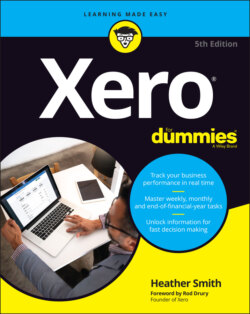Читать книгу Xero For Dummies - Heather Smith - Страница 63
Setting up bank accounts
ОглавлениеTo access the area to add a bank account, follow these steps:
1 From the organisation name in the top left corner of the screen, click on Settings in the drop-down list and then Looking for Advanced Settings? Under Advanced Settings, click on Chart of Accounts.
2 Click on the Add Bank Account button on the top left side.The Find Your Bank window opens.
3 Enter the name of the bank your business account is with in the Search for Your Bank … field.For example, in Australia you might enter ANZ or Suncorp in this field. Xero then suggests bank accounts that it recognises. Carefully select the matching bank. If your bank is there, hurrah! You should have access to automatic bank feeds. If, however, the bank isn’t recognised, try alternative names or abbreviations. If that still doesn’t work, transactions need to be manually imported. Manually importing bank statements is covered in Chapter 4.Once you have selected the correct bank name, the Enter Your Bank Account Details window opens.
4 Click the Account Name field and enter the business bank account name. When naming a bank account, suffix it with the last four digits of the bank account number for easy identification — for example, ABC Business x1234. When you refer to source documents such as shopping receipts or bank statements, they may include the last four digits of the account you paid from. This crosscheck allows for easy identification.If the bank name is recognised, you may get an option to add an Account Type as well. Click the field and select from the drop-down box. The remaining fields, while similar, are customised to the country the Xero file was set up for, as shown in Table 2-2. Currency options are available in all Xero Premium packages, irrespective of their region. The Code field does not appear if you set up the bank account from the Bank Accounts screen.
5 Select the Account Number fields and enter the required details. Some Australian banks utilise direct entry user identification when the business makes batch payments. If you’re in Australia and your bank uses these, Xero allows you to enter the Direct Entry User ID in the DE User ID field. When processing a payroll batch payment, a DE User ID field is a requirement. Enter the information and then check the self-balancing transaction option underneath. If you intend to make batch payments but you’re unsure whether your bank has a Direct Entry User ID associated with the account, just ask your account manager at your bank. Also check whether you need to include a self-balancing transaction in the ABA file. This field is optional — if unsure, leave it blank. (Batch payments are covered in Chapter 7.)
6 Select the currency that you’re working with in the Currency field (if required).You only need to select the currency if you’re working in multiple currencies. Multi-currency options are only available in the Premium version of Xero. Refer to Chapter 15 for guidance on setting up different currencies.If you need to add another account with the same bank, click the + Add Another Bank Account hyperlink and return to Step 4.TABLE 2-2 Xero Bank Account Settings Fields by RegionAustraliaNew ZealandSouth AfricaUnited KingdomUnited StatesGlobalBSBAccount NumberDE User IDInclude Self-balancing Transaction in the ABA FileBank Account NumberAccount NumberSort CodeAccount NumberBank Account NumberBank Account Number
7 Click the blue Continue button.Once saved, you may be given the option to download your partially filled-out bank feed application forms, which you can complete, sign and submit, as part of the process for activating the bank feeds. The account also appears on the Xero Dashboard. (Make sure you also set up bank feeds for your bank accounts — see Chapter 4 for more.)
